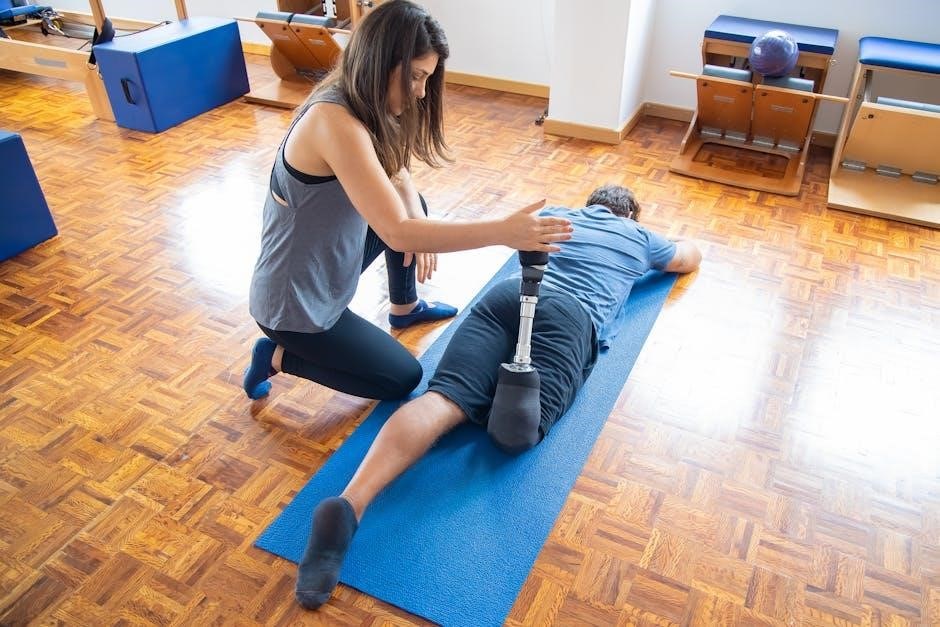
manual trainer mtb
An MTB manual trainer is a device designed to help mountain bikers practice and master the balance and control needed for manualing. It’s essential for developing bike handling skills and improving overall riding performance.
1.1 What is a Manual Trainer?
A manual trainer is a specialized device designed to help mountain bikers practice and refine their balance and control while performing manuals. It typically fixes the rear wheel, preventing forward pedaling, and allows riders to focus on finding and maintaining the optimal balance point. This tool is essential for developing the muscle memory and coordination needed for consistent and controlled manuals on various terrains. By simulating real-world conditions, it helps riders build confidence and precision in their bike handling skills.
1.2 Importance of Manual Training in MTB
Manual training is crucial for mountain bikers as it enhances balance, coordination, and overall bike control. Mastering manuals improves stability on technical terrains, reduces the risk of falls, and boosts confidence. Regular practice with a manual trainer helps develop muscle memory, enabling riders to maintain control in challenging situations. This skill is essential for advanced techniques and ensures safer, more efficient riding on diverse trails, making it a cornerstone of MTB skill development.

How to Use a Manual Trainer
Using a manual trainer involves assembling the device, securing your bike, and practicing balance. Start with short sessions, gradually increasing difficulty as skills improve. Always ensure proper setup and compatibility with your bike to maximize effectiveness and safety during training sessions; Regular practice helps build muscle memory and enhances overall control.
2.1 Assembly and Setup
Assembling a manual trainer involves securing your bike’s rear wheel to prevent movement, often using spacers for different tire widths. Ensure compatibility with your bike’s size and weight limit, typically up to 110kg. Remove the chain to replicate real manual conditions accurately. Position yourself over the bike, preferably on flat pedals for safety. Start on soft surfaces or with padding to prevent injuries. Always check brake functionality, especially the rear brake, to control tipping. Begin with short practice sessions, gradually increasing duration as comfort improves. DIY options, like building a base from 2x4s, offer cost-effective alternatives but require sturdy materials for safety. Combine trainer practice with real-world rides to enhance muscle memory and skill application.
2.2 Practicing Balance and Control
Start by standing over the bike on flat pedals for stability. Shift your weight slightly backward to lift the front wheel, engaging your core and keeping knees bent. Practice subtle body movements to maintain balance, focusing on the rear wheel’s contact point. Use the rear brake gently to prevent excessive tipping. Begin on level ground, gradually progressing to slight inclines as confidence grows. Short, consistent sessions help build muscle memory and control, essential for mastering real-world manuals safely and effectively.

2.3 Progressing to Real-World Manuals
Once comfortable on the trainer, transition to real-world terrain. Start with slight inclines or flat ground, using the skills learned. Focus on shifting weight, engaging the rear brake, and maintaining balance. Practice short manuals, gradually increasing duration and difficulty. Incorporate obstacles like small rocks or logs to simulate trail conditions. Regular practice on varied surfaces builds confidence and muscle memory, helping you master manuals in dynamic, real-world scenarios safely and effectively.

Benefits of Using a Manual Trainer
A manual trainer enhances balance, coordination, and muscle memory, reducing the risk of falls. It strengthens essential skills, builds confidence, and improves overall riding efficiency effectively.
3.1 Improved Balance and Coordination
A manual trainer enhances balance and coordination by allowing riders to practice precise body positioning and weight distribution. Fixing the rear wheel forces focus on subtle movements, improving core engagement and overall stability. Regular use develops muscle memory, making it easier to maintain balance during manuals. This targeted training helps riders master the balance point, reducing wobbles and building confidence for real-world applications.
3.2 Enhanced Muscle Memory
Consistent practice on a manual trainer builds muscle memory, enabling riders to perform manuals instinctively. Repetitive balancing exercises strengthen neural pathways, making manualing feel more natural over time. The trainer’s fixed rear wheel forces riders to rely on precise body movements, reinforcing proper techniques and improving overall muscle coordination. This repetition translates to real-world scenarios, helping riders maintain control and execute manuals effortlessly on the trail.
3.3 Reduced Risk of Falls
A manual trainer significantly reduces the risk of falls by allowing riders to practice balancing in a controlled environment. The fixed rear wheel prevents the bike from tipping over, giving riders confidence to experiment with their balance points. This safe setup minimizes accidents during practice, helping riders master the technique before applying it on the trail. By building balance and control, manual trainers enable riders to perform manuals more safely in real-world scenarios.

Types of Manual Trainers
Manual trainers include rear-wheel balance devices and DIY setups, providing riders with portable and customizable tools for safe and effective manual training sessions at home.
4.1 Rear-Wheel Balance Trainers
Rear-wheel balance trainers are specialized tools designed to isolate the rear wheel, allowing riders to practice lifting the front wheel and maintaining balance. They are highly popular among MTB enthusiasts as they provide a safe and controlled environment for mastering manuals. These trainers typically feature a sturdy frame that fixes the rear wheel in place, enabling riders to focus on their body positioning and weight distribution. Many models also include adjustable features to suit different bike sizes and rider preferences, making them versatile for both beginners and advanced riders. Their compact design ensures portability, allowing users to train anywhere, from home to the trailhead. By simulating real-world conditions, rear-wheel balance trainers help build the muscle memory and confidence needed for successful manuals on the trail.
4.2 DIY Manual Trainer Options
DIY manual trainers offer a cost-effective and customizable solution for riders. Using basic tools and materials like wood or metal, riders can create their own balance trainers. These homemade setups often involve a frame that stabilizes the rear wheel, allowing practice of manuals without the need for commercial products. DIY options are ideal for those on a budget or with handyman skills, providing a fun and practical way to improve balance and control. They also encourage creativity and understanding of the mechanics behind manualing.
Safety Tips and Precautions
Always start on flat ground and wear safety gear. Ensure the trainer is stable and check weight limits. Avoid overleaning to prevent accidents during practice sessions.
- Begin on flat, stable ground.
- Wear protective gear, including a helmet.
- Check the trainer’s weight limit and compatibility.
5.1 Proper Use of the Trainer
Start on flat, stable ground and ensure the bike is compatible with the trainer. Always maintain balance, as the trainer won’t hold the bike firmly. Practice controlled movements, engaging the rear brake if needed to prevent over-rotation. Regularly inspect the trainer for wear and tear. Follow assembly instructions carefully, ensuring all parts are secure. For DIY models, use sturdy materials and double-check measurements before use to ensure stability and safety during training sessions.
- Begin with short practice sessions to build confidence.
- Keep the bike within the recommended weight limit.
5.2 Understanding the Risks
Using a manual trainer carries inherent risks, including instability and potential falls. Over-rotation or improper balance can lead to loss of control. Exceeding the weight limit may compromise the trainer’s stability. Improper assembly or use of low-quality materials, especially in DIY models, can increase the risk of equipment failure. Always follow the manufacturer’s guidelines and ensure the bike is compatible with the trainer to minimize these risks and enhance safety during practice sessions.
- Be mindful of your bike’s weight and compatibility.
- Inspect the trainer regularly for damage or wear.

Choosing the Right Manual Trainer
Choosing the right manual trainer involves considering compatibility with your bike, durability, and adjustability. Opt for a model that suits your skill level and training goals.
6.1 Compatibility with Your Bike

Ensure the manual trainer is compatible with your bike’s tire width, axle type, and wheel size. Check weight limits and cassette compatibility to avoid damage. Most trainers support 26-29″ MTB or 700C road wheels and Shimano/Sram cassettes. Foldable designs offer easy storage and portability. Verify maximum weight capacity, typically up to 110kg, to ensure safety and stability during practice sessions. Proper compatibility ensures optimal performance and prevents potential issues.
6.2 Key Features to Look For
Look for a sturdy, durable construction to withstand regular use. A foldable design offers portability and easy storage. Ensure the trainer is easy to assemble and disassemble. Check the weight capacity, typically up to 110kg, to ensure it can support your bike and rider. Adjustable features, like accommodating different tire widths, are essential for versatility. Some trainers also offer additional functions like progress tracking or climb simulation for enhanced training.

Best Practices for Effective Training
Consistency is key; practice regularly to build muscle memory. Start with short sessions and gradually increase duration. Combine manual training with other exercises for well-rounded skills. Always warm up before sessions and focus on proper technique to avoid bad habits. Incorporate real-world scenarios to apply your skills effectively. Stay patient and persistent, as mastering manuals takes time and dedication.
7.1 Regular Practice Routine
A consistent practice routine is crucial for improving manual skills. Start with short, 15-20 minute sessions, 3-4 times a week, and gradually increase duration as you build confidence. Always begin with a warm-up to prepare your body and focus your mind. Focus on proper technique and maintain a steady progression. Track your progress to stay motivated and adjust your routine as needed. Consistency and patience are key to mastering the manual.
7.2 Combining with Other Training Exercises
Combining manual trainer workouts with other exercises enhances overall mountain biking performance. Incorporate strength training to build core and leg muscles, which are essential for stability. Balance exercises, such as standing on a balance board, improve coordination. Technique drills, like practicing manuals on flat ground, reinforce proper form; Cardiovascular exercises, such as short sprints or interval training, boost endurance, allowing riders to maintain manuals longer. Integrating these exercises creates a well-rounded training regimen for mastering manuals and advancing MTB skills.
An MTB manual trainer is an invaluable tool for developing the balance, control, and muscle memory needed to master manuals. By providing a safe and focused environment for practice, it helps riders progress from basic skills to real-world application. Whether you’re a beginner or an advanced rider, consistent use of a manual trainer can significantly enhance your overall biking performance and confidence on the trails.

